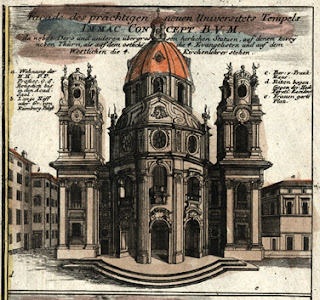I first saw Salzburg in the summer of 1967. My friend and I were in a caravan and horrified at the prices of the candlelight concerts in the Schloss Mirabel and saw the 'great and good' in their evening dress and furs coming out of the Festspielhaus Mozart Zauberflote..... The Cathedral was a dose of cold water to me and I don't remember the University Church. In fact it was my fourth visit before I went inside! Only now in retrospect do I appreciate its attraction and importance externally. Of the inside I remember the bareness but little else. What an admission! I will try to make amends revisiting it now from my desk in St Albans, UK.
In the later 17th century the Benedictine University of Salzburg did not have a separate church and the same building housed secular events and church services. This was unacceptable to Prince-Archbishop Johann Ernst and he decreed a new church in 1694. At this time other major building projects for the Prince-Archbishop were being done by Johann Bernhard Fischer von Erlach so it was natural for him to get the job. He was based in Vienna, like his rival Johann Lucas van Hildebrandt. Both were architects who design and manage, but do not supervise the construction. The Kollegienkirche is Fischer's second Salzburg church and turned out to be a masterpiece. He was using the same site which others had planned a church under Prince-Archbishop Paris Lodron. Fischer used a double Greek cross, increased the size and progress was slow because other modifications were made during the construction 1696-1707. The facade brings to mind Borromini, Guarini and Bernini.
Bells and a gallery organ were added in 1708. The various chapel altars were added in the 1720s. The high altar designed by Fischer was rebuilt in 1738. This meant the church was complete. Vault frescos were not favoured. Fischer's church was to be his white temple.
The Church came through the Napoleonic War, the secularisation of abbeys in 1803 and other political changes in Salzburg, without major damage. It was reconsecrated in 1812 and got through the 19th century unscathed except for the loss of the Baroque organ. There were major renovations in 1863/3, 1866 and 1882 and several times in the 20th century - the latest 2003-13. I suspect this was going on during my last visit. I do not remember it as a church, more of a performance space, and indeed today it is used for exhibitions and concerts (just like our own Cathedral in St Albans a few hundred yards from I sit : there is a Sound and Light Show on tonight).
The interior is lofty with barrel-vault nave and transept and a light filled dome. The use of space by Fischer originates from Roman and French models discovered while in Italy and this, combined with lots of light and no colour, produces an overwhelming effect. Use of stucco apart from the chancel is restricted,. In the latter Fischer has required two white triumphal columns with huge pedestals, and then the apse is dominated by the stucco of the Immaculate Conception with clouds and angels.
Overall I guess this great church is the forerunner of Weingarten, Ottobeuren and St Gallen. What more could I want?
This video gives a good idea of the atmosphere




No comments:
Post a Comment